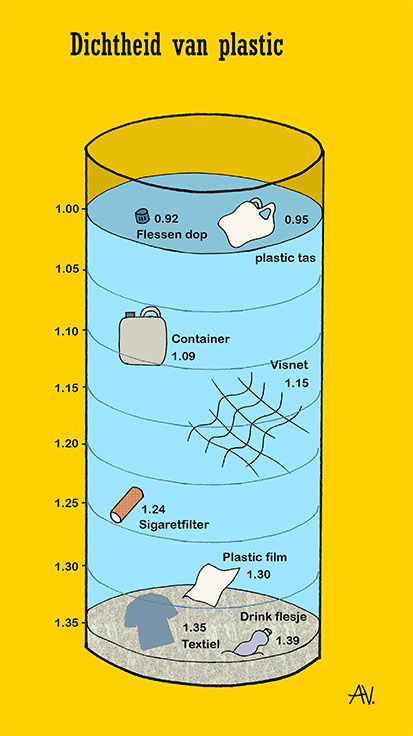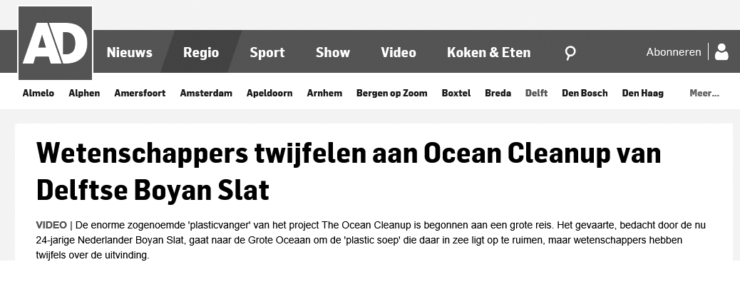Plastic can be found everywhere in the ocean
Contrary to what many people think, the ocean isn’t covered with plastic bags, and there aren’t ‘islands of plastic’ floating on the surface. But that’s because less than 1% of the plastic floats on the surface. Most of the plastic floats deeper in the water column, or sinks to the sea floor.
Why doesn’t plastic always float on the surface?

Did you know… that only half of the plastic waste floats on water? The rest is heavier than water and sinks towards the ocean floor.
Plastic has a certain density, so not all plastic floats on the ocean surface. If the density is greater than that of sea water, the plastic will sink, and the plastic floats if it is less dense than water.
Half of the plastic waste in the ocean consists of floating plastic 1, such as plastic bags and bottlecaps. The rest is denser than seawater, so it sinks 2. When the plastic sinks, it is carried by ocean currents to the sea floor, where it stays for a very long time 3,4,5.
< 1% of the plastic in the ocean floats on the surface
Researchers estimate that less than 1% of the plastic in the ocean floats on the surface. But how do they know that? Let’s add it up.

If less than 1% of the plastic in the ocean can be found floating on the surface, then where is the other 99%?
Calculating…
Since plastic was first produced in 1950, over 86,000 million kilos of plastic has reached the ocean 6. More than half of that will float, which means that there is 57,000 million kilos of floating plastic waste in the world today. Between 60 and 64% of that plastic waste is estimated to have been washed from coastal areas into the sea 7. which means that 34,000 million kilos of floating plastic has entered the open ocean at some point. However, researchers have only observed 93-236 million kilos actually floating on the ocean surface today 8. That’s less than 1% of all of the plastic that has reached the ocean, which means that the other 99% must be somewhere other than the surface of the water. So where is it? We simply don’t know.
Plastic in the ocean: clean it up, or let it float?
Many people are focused on collecting the plastic floating in the ocean, including the Ocean Clean-up project by Boyan Slat. But floating plastic represents less than 1% of all of the plastic in the ocean. The other 99% of the plastic soup receives far less attention. The Ocean Clean-up project has therefore received its fair share of criticism, based on the idea that it’s not an effective solution. Watch this video by the AD, and decide for yourself whether the Ocean Clean-up is a good idea or not.

Would you like to know why scientists don’t believe that the Ocean Clean-up will work? Then watch this video by the AD.
2 Engler (2012) The Complex Interaction between marine Debris and Toxic Chemicals in the Ocean. Environmental Science & Technology, 46, 12303-12315.
Van Cauwenberghe, L., & Janssen, C.R. (2014) Microplastics in bivalves cultured for human consumption. Environmental Pllution, 193, 65-70.
4 Pham, C. K., Ramirez-Llodra, E., Alt, C. H., Amaro, T., Bergmann, M., Canals, M., … & Huvenne, V. A. (2014). Marine litter distribution and density in European seas, from the shelves to deep basins. PloS one, 9(4), e95839.
5 Woodall, L. C., Sanchez-Vidal, A., Canals, M., Paterson, G. L., Coppock, R., Sleight, V., … & Thompson, R. C. (2014). The deep sea is a major sink for microplastic debris. Royal Society open science, 1(4), 140317.
6 Jang, Y. C., Lee, J., Hong, S., Choi, H. W., Shim, W. J., & Hong, S. Y. (2015). Estimating the Global Inflow and Stock of Plastic Marine Debris Using Material Flow Analysis. Korean Society for marine Environment and Energy, 18(4), 263-273.
7 Lebreton, L. M., Greer, S. D., & Borrero, J. C. (2012). Numerical modelling of floating debris in the world’s oceans. Marine Pollution Bulletin, 64(3), 653-661.
8 van Sebille, E. (2015) The ocean’s accumulating plastic garbage. Physics Today, 68, 60-61. – Website
More interesting info..





